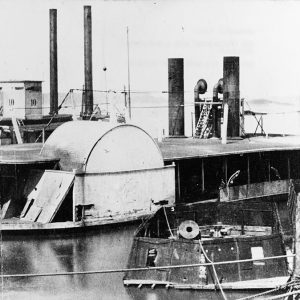calsfoundation@cals.org
USS Linden
aka: Tinclad No. 10
The USS Linden, a gunboat in the Union navy, served in the Vicksburg Campaign and on Arkansas waterways prior to hitting a snag and sinking in the Arkansas River in early 1864.
The Linden was a 177-ton wooden sidewheel paddleboat built in 1860 at Belle Vernon, Pennsylvania. The vessel was 154 feet long and thirty-one feet wide with a four-foot draft. In 1861, the Linden ran between Pittsburgh, Pennsylvania, and Cincinnati, Ohio; by early 1862, the steamer was transporting U.S. Army wagons and supplies from Cincinnati to Louisville, Kentucky. The U.S. Navy bought the boat on November 20, 1862, and it was commissioned as the USS Linden (Tinclad #10) at Cairo, Illinois, on January 3, 1863.
The USS Linden, armed with six twenty-four-pounder howitzers, took an active part in the Mississippi River campaign to capture the Confederate bastion at Vicksburg, Mississippi, including expeditions up the Yazoo River to cut off Vicksburg from the north and one to Yazoo City in which the rebels burned their naval yard and several vessels—including the CSS General Earl Van Dorn—to prevent their capture. The USS Linden also took part in the punitive Burning of Mound City on January 13, 1863. Vicksburg surrendered on July 4, 1863.
Following Vicksburg’s fall, the USS Linden undertook convoy and reconnaissance duties on the Mississippi River, often branching into such tributaries as the White and Arkansas rivers. In August 1863, the Linden ran a pair of coal barges up the White to Clarendon (Monroe County) to convoy Union troops heading west from Crowley’s Ridge and Helena (Phillips County) across the White during the campaign to gain control of Little Rock (Pulaski County), a goal achieved on September 10, 1863.
On February 18, 1864, the steamboat Ad. Hines struck a snag about eight miles below Pine Bluff (Jefferson County) and sank. The Linden was dispatched to assist the stricken steamer. When about 400 yards from the Hines at 7:45 a.m. on February 22, it hit a snag at Carson Towhead on the Arkansas River, one that pierced its port bow and tore a ninety-foot gash in the vessel’s hull. “In fifteen minutes after she struck she filled with water, commenced hogging badly and careening over to starboard, the snag coming up through her bottom at the port magazine,” Acting Master Thomas M. Farrell reported.
Though the Linden’s pilots held that the vessel could be refloated, Farrell did not agree and ordered his crew to remove its guns and ammunition, supplies, engines, and armor plating, having it all transported to the Union base at Pine Bluff. The hulk of the USS Linden was apparently abandoned on March 2, 1864.
For additional information:
“Linden I (Sidewheel Steamer).” Dictionary of American Naval Fighting Ships. https://www.history.navy.mil/research/histories/ship-histories/danfs/l/linden-i.html (accessed December 15, 2022).
“USS Linden (1).” Navsource.org. http://www.navsource.org/archives/09/86/86093.htm (accessed December 15, 2022).
The War of the Rebellion: A Compilation of the Official Records of the Union and Confederate Navies. Vol. 25. Washington DC: Government Printing Office, 1912, p. 352–353, 774–785.
Way, Frederick, Jr. Way’s Packet Directory. Athens: Ohio University Press, 1983.
Mark K. Christ
Central Arkansas Library System








Comments
No comments on this entry yet.